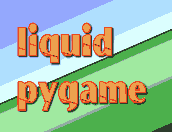Se hai installato pygame
pip install pygamepuoi eseguire il codice originale scrivendo le istruzioni
import pygame.examples.liquid
pygame.examples.liquid.main()Versione riarrangiata

Salva l’immagine nella sottocartella data
import pygame as pg import os # path.split(), path.join() import math # sin() import time # sleep() def main(): pg.init() screen = pg.display.set_mode((640, 480), pg.HWSURFACE | pg.DOUBLEBUF) main_dir = os.path.split(os.path.abspath(__file__))[0] imagename = os.path.join(main_dir, "data", "liquid.bmp") bitmap = pg.image.load(imagename) bitmap = pg.transform.scale2x(bitmap) bitmap = pg.transform.scale2x(bitmap)# get the image and screen in the same format if screen.get_bitsize() == 8: screen.set_palette(bitmap.get_palette()) else: bitmap = bitmap.convert() anim = 0.0 xblocks = range(0, 640, 20) # 0, 20, 40,..., 620 yblocks = range(0, 480, 20) # 0, 20, 40,..., 460 while True: for e in pg.event.get(): if e.type in (pg.QUIT, pg.KEYDOWN, pg.MOUSEBUTTONDOWN): return anim = anim+0.02 for x in xblocks: xpos = 20+(x+15*(math.sin(anim+x*0.01))) for y in yblocks: ypos = 20+(y+15*(math.sin(anim+y*0.01))) screen.blit(bitmap, (x,y), (xpos,ypos, 20,20)) pg.display.flip() time.sleep(0.005) if __name__ == "__main__": main() pg.quit()